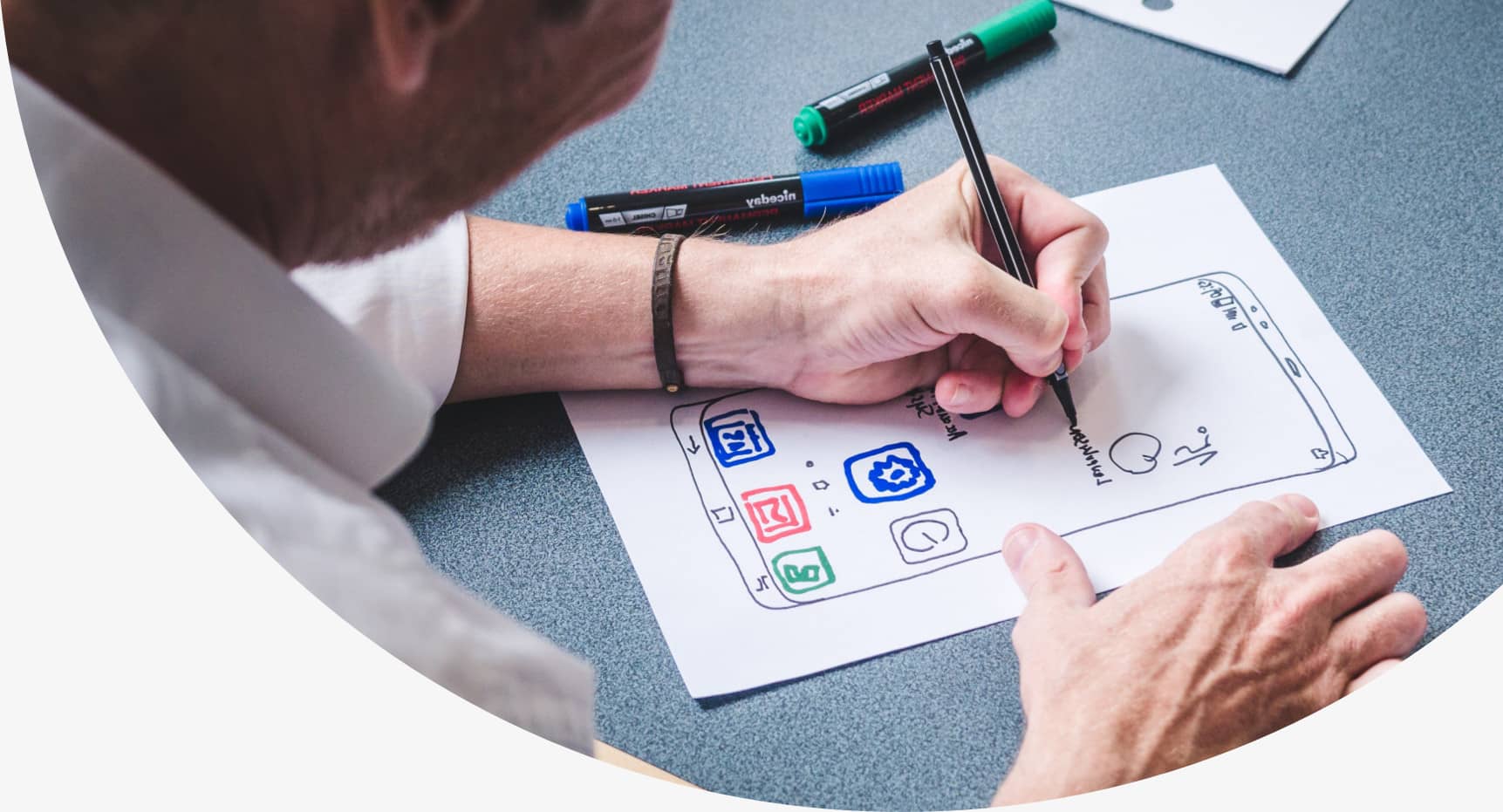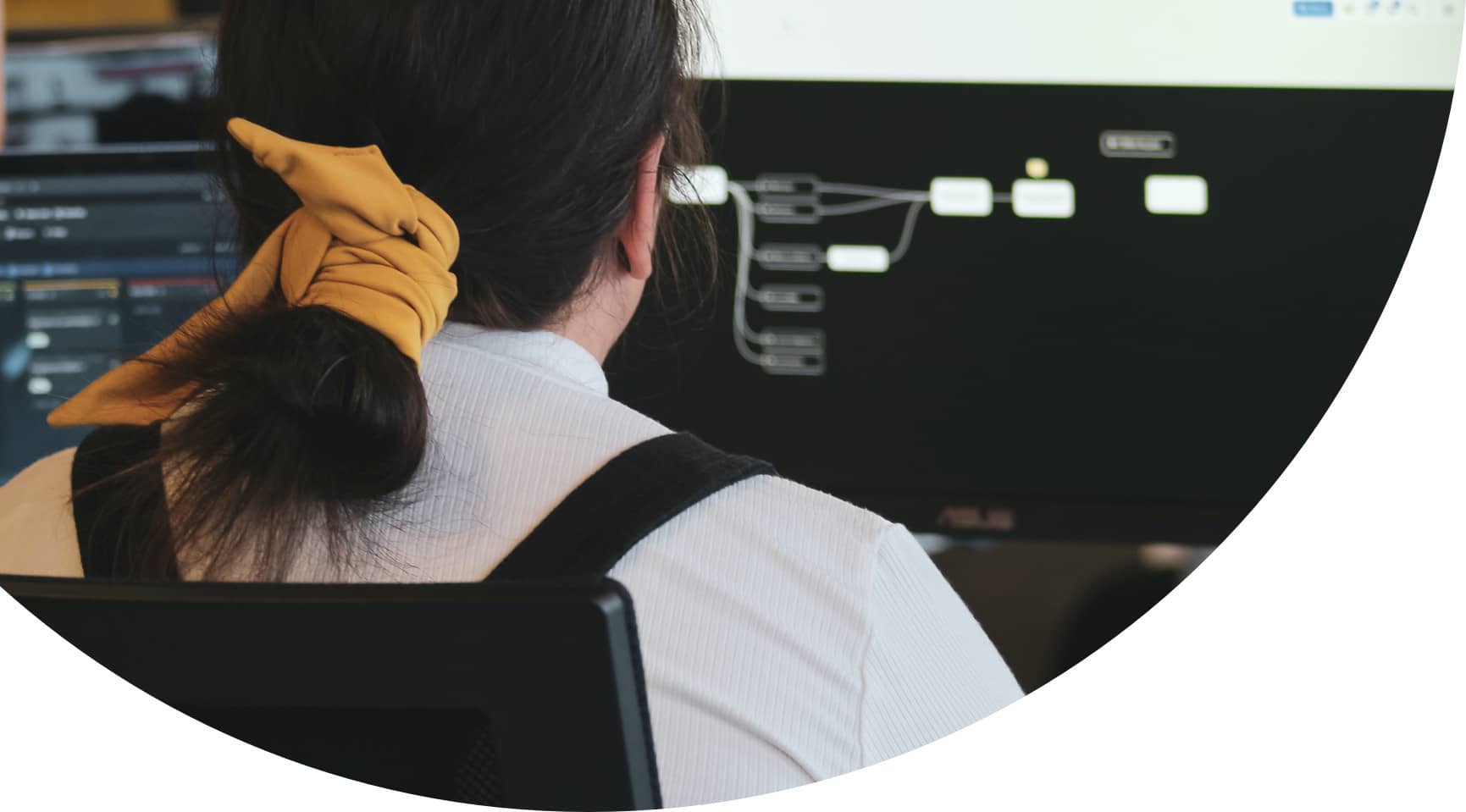It draws heavily from the methodologies of designers, and has been used extensively by engineers, architects, entrepreneurs and other professions. At its core, design thinking encourages people to develop innovative designs by keeping a user’s perspective front and centre when undertaking projects.

Design thinking is a user-
centric approach to
practical and creative
problem solving.
Importance of
Design Thinking
The main advantage of design thinking is that it facilitates solutions that effectively meet human needs. This human-centric approach is grounded in empathy, and often informed by user feedback, to ensure the development of pioneering designs.
When done correctly, this allows for a design, which draws user focus away from the interface and toward the intended interaction. For instance, if your website’s user journey from product pages to checkout is simple, clear, and obvious, then it has been designed effectively.
At Vsourz, we use the design thinking process to ensure your visitors have a seamless journey throughout your website. In doing so, we help you to boost conversion rates in the process.
The Three E’s: Utilising the
Principles of Design Thinking
At Vsourz, we place the core principles of design thinking at the centre of our problem solving. Otherwise known as the three E’s, these are: empathy, expansive thinking, and experimentation.
Empathy
Design thinking encourages empathy, placing user problems, feelings, and needs at the centre of the creative process. This helps designers to develop effective solutions to real-world problems.
Expansive Thinking
Expansive thinking (also referred to as brainstorming), is used to develop a whole range of possible solutions or approaches. This entails looking at the problem from as many different angles as possible. In doing so, it makes it possible to develop revolutionary new ideas.
Experimentation
Once a range of creative ideas have been developed, experimentation is used to gauge which ones are the most effective. This involves creating beta versions of sites or apps that are tested on a small sample of users. Gathering data on these allows for an evaluation of whether to abandon, adjust, or progress with them.
Our Design Thinking Strategy
We have a five-stage process through which we bring the principles of design thinking to bear on our projects.

Stage One: Empathise
In the first step, our design thinking experts gain a deep understanding of your target audience through observation and interaction. This enables us to become fully aware of your users’ identities, problems, and expectations.
Specifically, empathy is built through design thinking methodology. This includes the use of user surveys, semi-structured interviews, and participant observation sessions.
Stage Two: Define
Using the data gathered from the empathise step, our team next clearly defines the problem. This provides the project with focus, giving it a specific challenge to overcome.
Importantly, the work conducted in the prior step will ensure that the problem definition is human-centric.
Stage Three: Ideate
Once the problem has been clearly defined, Vsourz will next produce a wide range of possible solutions. In effect, this is casting a wide net. We develop multiple solutions because this increases the chances of landing upon an innovative and effective one.
To achieve this, we employ a selection of tried-and-tested ideational techniques such as reverse thinking and brainstorming. Often, we will also include a range of different stakeholders in these sessions. This serves to broaden the perspectives of those involved and thus yield richer results.
Stage Four: Prototype
Next, we identify a small number of our best ideas, and then build prototypes of these. They can take the shape of beta-versions of applications, specific landing pages, or even the core parts of an entire website. Crucially, these will be specifically designed to test whether our approach solves the problem defined in stage two.
Stage Five: Test
The prototype allows us to test the effectiveness of our solutions with groups of real users. From there, we gather feedback from these people to highlight what works well and what we need to improve. This helps us to maintain our human-centric approach.
Stage five involves running sessions where we observe users as they interact with the prototype. We then triangulate this data with semi-structured interviews, through which we can elicit detailed feedback, impressions, and insights.
The findings of these sessions determine whether we do additional work on the solution, proceed with production, or implement another idea altogether.

Benefits of Design Thinking
in Business
Design thinking management can bestow a number of advantages upon your company. These include:
- Improving the predictability of product and business success.
- Providing a competitive advantage through solutions based on commonly overlooked user behaviours, motivations, and obstacles to conversion.
- Making the design experience an inclusive and collaborative one. By encouraging broad participation in the creative process, design thinking fosters empathy and helps produce an open and productive culture.
What can Vsourz do to Leverage
Design Thinking for Your Company?
At Vsourz, we have years of experience in implementing design thinking principles and methodologies to address a range of client problems. In the course of this, we have developed deep expertise and built up an extensive skill set. Below is a non-exhaustive list of methods that we can draw upon to help develop effective solutions for your business:
-
Qualitative research methodologies.
- Semi-structured user interviews.
- Participant user observation.
- Focus groups.
- Qualitative user surveys. -
Quantitative methodologies.
- Quantitative user surveys.
- User research.
- Statistical analysis.
- Developing user personas for empathetic designs.
- Creating user journey maps.
- Using empathy mapping to ascertain how users think, feel, and act.
- Analysing user needs, expectations, and behaviours.
- Creating business goal maps.
- Building empathetically designed information architecture and navigations.
- Developing wireframe and interactive prototypes.
- Utilising multi-sensory designs.
- Employing a design thinking iterative process informed by user feedback.
Vsourz Utilises Design Thinking
Analysis to Help You Find Success
Our proven design thinking expertise means we are well placed to help you develop innovative
solutions. But it doesn’t stop there; we also make ideas happen. Speak to our team today, and you
too could benefit from design thinking led by our digital experts.
solutions. But it doesn’t stop there; we also make ideas happen. Speak to our team today, and you
too could benefit from design thinking led by our digital experts.
Contact Us
Contact our team to chat about
what we can do for your brand.
Subscribe to our Newsletter
We’ ll send the latest special offers and news straight to your inbox!



